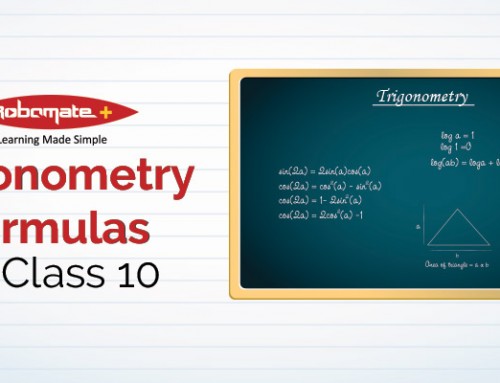1. If perimeter of a circle is equal to that of a square, What would be the ratio of their areas.
Here, perimeter of circle = 2πr and perimeter of square = 4a
∴2πr = 4a ⇒r=2aπ
∴ Ratio of their areas = πr2a2 = πa2×(2aπ)2
= πa2×(4a2π2) = 4π = 422×7 = 1411
2. Find the areas of circle that can be inscribed in a square of side 8 cm.
Diameter of the circle = Side of the square
∴ Diameter = 8 cm
⇒ Radius = 82 = 4 cm
∴ Area of the circle = π×4×4 cm2
= 9π cm2
3. If sum of the areas of two circles with radii R1andR2 is equal to area of a circle radius R, derive the relation among their radii.
Since sum of areas of two circles with radii R1andR2 = Area of circle with radii R.
⇒ πR21+πR22=πR2
⇒ R21+R22=R2 or R = R21+R22−−−−−−−√
4. If sum of the circumference of two circles with radii radii R1andR2 is equal to circumference of a circle radius R, derive the relation among their radii.
Since sum of circumference of two circles with radii R1andR2 = Circumference of circle with radii R.
⇒ 2πR1+2πR2=2πR
⇒ R1+R2=R
5. If the circumference of a circle and the perimeter of a square are equal, then write the relation between their radii.
Since sum of circumference of a circle = Perimeter of a square
⇒ 2πr=4×side
⇒ r=2π×side
∴ Area of circle = π×4π2×(side)2
= 4π(side)2
= 2822(side)2
Area of square = (side)2
Since 2822(side)2 > (side)2
6. To build a single circular park equal in area to the sum of areas of two circular parks of diameter 8 m and 6 m in a locality. What would be the radius of new park?
Here, area of single park = Area of the park with (d= 8m) + Area of the park with (d= 6m)
⇒ πR2=π(4)2+π(3)2
⇒ πR2=π(16+9)
⇒ R2=25
⇒ R = 5 m.
7. Find the area of a square that can be inscribed in a circle of radius 6 cm.
Since square is inscribed in a circle
⇒ Diagonal of square = Diametre of circle
⇒ 2–√×side = 12
Side = 122√ cm
Now, area of the square = 122√×122√ = 72 cm2
8. Find the radius of a circle whose circumference is equal to the sum of the circumference of two circles of diameter 24 cm and 16 cm.
From the above, we obtain
2πR=2πR1+2πR2
⇒ R=R1+R2
⇒ R = 12 + 8 = 20 cm
9. Find the diameter of a circle whose area is equal to the sum of the areas of the two circles of radii 20 cm and 15 cm.
From the above, we obtain
πR2=πR21+πR22
⇒ R2=R21+R22
⇒ R2=(20)2+(15)2 = 400 + 225 = 625
⇒ R = 25 cm
10. Find the area of the largest triangle that can be inscribed in a semicircle of radius r.
Here, among all altitudes, radius is the largest altitude

∴ Areaof△PQR=12×2r×r
= r2sq.units
Hence, area of the largest triangle inscribed in a semicircle r is r2sq.units.
11. In the given figure , a square of diagonal 14 cm is inscribed in a circle. Find the area of the shaded region.

Here, diagonal of the square = 14 cm
⇒ 2–√×side = 14
⇒ side = 142√ cm
∴ Area of the square = 82√×82√ = 98 sq.cm
Diameter of the circle = 14 cm
∴ Radius of the circle = 7 cm.
Area of the circle = π(4)2 = 227×49 = 154 sq.cm
Thus, area of the shaded region = 154 – 98
= 56 sq.cm
12. The wheel of a motor cycle is of radius 28cm. How many revolutions per minitue must the wheel make so as to keep a speed of 60 Km/h?
Here, speed of the motor cycle = 60 Km/h
= 6000060 m/min
= 1000 m/min
Radius of the wheel (r) = 28 cm = 28100 m.
Circumference of the wheel = 2×227×28100 m
= 1.76 m
Number of revolutions per minute = 10001.76
= 568.18
13. A cow is tied with a rope of length 21 m at the corner of a rectangular field of dimensions 27 m × 23 m. Find the area of the field in which the cow can graze.
Length of the rope = 21 m
∴ Area of the field in which the cow can graze

= 90°360°×227×21×21
= 346.5 m2
14. In the given fig, arcs are drawn by taking vertices P,Q and R of an equilateral triangle of side 12 cm to intersect the sides QR, RR and PQ at their respective mid-points X, Y and Z. Find the area of the shaded region.

Side of an equilateral m2△ PQR = 12 cm
Since, arcs are drawn by taking vertices P,Q and R to intersect the sides QR, RR and PQ at their mid-points X, Y and Z.
∴ Radii of each sector (r) = 6 cm
Also, m2△ PQR is an equilateral, therefore
∠P=∠Q=∠R=60°
Required area of the shaded region
= 3×θ360°×πr2
= 3×60°360°×3.14×62
= 3×16×3.14×36
= 56.52 cm2
15. In the given fig, arcs have been drawn with radii 7 cm each and with centers A, B and C.
Find the area of the shaded region.

Here, radii of each sector at A, B and C is 7 cm
Let ∠A=θ1°∠B=θ2°,∠C=θ3°
Required area of shaded region
= θ1°360°πr2+θ2°360°πr2+θ3°360°πr2
= πr2360°(θ1°+θ2°+θ3°)
= 22×7×77×360°×180° [Sinceθ1°+θ2°+θ3°=180°]
= 77 cm2
16. A circular park is surrounded by a road 20 m wide. If the radius of the park is 100 m, find the area of the road.

Here, radius of the circular park (r) = 100 m
Width of the road = 20 m
∴ Radius of the outer circle (R) = 100 + 20 = 120 m
Required area of road
= πR2+πr2
= π (R + r) (R – r)
= 227 (120 + 100) (120 – 100)
= 227×220×20 = 13816 m2
17. A piece of wire 22 cm long is bent into the form of an arc of a circle subtending an angle of 90° at its center. Find the radius of the circle.
Here, length of wire (arc of required circle) = 22 cm
And central angle(θ) = 90°
Let r be the radius of the required circle.

∴θ360°×2πr = length of the arc
∴60°360°×2×227r = 20
⇒r=22×7×360°60°×2×22 = 21 cm
18. The length of the minute hand of a clock is 7 cm. Find the area swept by the minute hand during the time period 6:05 A.M and 6:40 A.M.
Angle swept by the minute hand in one minute = 6°
∴Angle swept by the minute hand in 35 minute = (6×35)°=210°
Length of the minute hand = 7 cm
Area swept by the minute hand = 210°360°×227×7×7
= 89.83 cm2
19. Find the area of the sector of a circle of radius 7 cm, if the corresponding arc length is 4 cm.
Radius of the circle (r) = 7 cm
Length of the arc = 3.5 cm
∴ θ360°×2πr = 4 cm
⇒θ360°×2×227×7 = 4
⇒θ360° = 4×72×22×7 = 111
Now, area of the corresponding arc
= 111×227×7×7
= 14 cm2
20. A circular pond is of diameter 20 m. It is surrounded by a 2 m wide path. Find the cost of constructing the path at the rate of Rs.30 per m2.
Radius of the circular pond r = 202 = 10 m
Width of the path = 2 m

∴ Radius of the outer circle (R) = 10 + 2 = 12 m
Area of the path = πR2−πr2
= π (R + r) (R – r)
= 227 (12 + 10) (12 – 10)
= 227×22×2 = 138.16 m2
Cost of constructing the path @ Rs.30 per m2
= Rs.4144.8
21. Find the number of revolutions made by a circular tier of area 1.32 m2 in rolling a distance of 165 m.
Area of a circular wheel = 1.32 m2
πr2 = 1.32
r2 = 1.32×722 = 0.42
r = 0.42−−−−√ = 0.648 m
Distance traveled in one rotation = 2πr
= 2×227×0.648
= 4.07 m
Total distance to be travelled = 165
∴Number of rotations = 1654.07 = 40.54
22. Find the difference of the areas of sectors of angle 90° and its corresponding major sector of a circle of radius 14 cm.
Radius of the circle (r) = 14 cm
Angle of the sector θ=90°

∴ Area of the sector = θ360°×πr2
= 90°360°×227×14×14
= 154 cm2
Area of major sector
= 360°–90°360°×227×14×14
= 462 cm2
∴ The required distance = 308 cm²
23. Find the area of the shaded region in the give figure.

Here, unshaded region is combination of two semicircles and one rectangle.
∴ Area of unshaded region = Area of rectangle with dimensions (26-3-3-) cm by (12-4-4) cm + 2 area of semicircle with radii (12−4−42)
= 16×4+2×12×π×2×2
= (64+4π) cm2
Required area of shaded region
= 26×12−(64+4π)
= 312 – 64 – 4π
= (248 – 4π) cm2
24. Find the area of the minor segment of a circle of radius 28 cm, when the angle of the corresponding sector is 90°.
Radius of the circle (r) = 28 cm
Central angle (θ) = 90°
Area of minor segment

= Area of sector PRQ – Area of △PRQ
= 90°360°×227×28×28−12×28×28×sin90° 90°
= 616 – 392
= 224 cm2
25. The diameter of front and rear wheels of a tractor 70 cm and 2 m respectively. Find the number of rotations that rear wheel will make in covering a distance in which the wheel makes 1200 rotations.
Radius of the front wheel (r) = 35 cm
Number of rotations = 1200
∴ Total distance covered by front wheel = 1200 2πr
= 1200×2×227×35
= 264000 cm
Radius of the rear wheel (R) = 2002 = 100 cm
Distance covered by the rear wheel in one rotation = 2×227×100
26. Number of rotations = 264000×72×22×100 = 420Sides of a triangular field are 15 m, 16 m and 17 m. With the three corners of the field a cow, a buffalo and a horse are tied separately with ropes of length 7 m each to graze in the field. Find the area of the field which cannot be grazed by the three animals.

Length of the rope = 7 m
Sides of the triangular field are AB = 16 m, BC = 17 m and AC = 15 m
Let cow, buffalo and horse be tied at vertices A, B and C respectively.
∴ Area of △ ABC = 24(24−15)(24−16)(24−17)−−−−−−−−−−−−−−−−−−−−−−−√
= 24×9×8×7−−−−−−−−−−−√ = 2421−−√ m2
Hence, area of the field which cannot be grazed by three animals = (2421−−√−77) m2
27. Find the area of the flower bed ( with semi- circular ends) as shown in the figure.

Here, the flower bed is a combination of two semicircular ends and rectangle.
Radius of semicircular ends = 7 cm
Length and breadth of rectangular field are 35 cm and 8 cm
∴ Area of the shaded region
= 2×12πr2+l×b
= 227×7×7+35×8
= 154 + 280
= 434 cm2
Hence, area of the flower bed is 434 cm2.
28. On a square cardboard sheet of area 196 cm2, four congruent circular plates of maximum size are placed such that each circular plate touches the other two plates and each side of the square sheet is tangent to two circular plates. Find the area of the square sheet not covered by circular plates.

Area of the square PQRS = 196 cm2
Side of the square = 196−−−√ = 14 cm
∴ Diameter of each circular plate = 7 cm
And radius of each circular plate = 3.5 cm
Area of four circular plates = 4×227×3.5×3.5
= 154 cm2
Area of the square sheet not covered by the circular plate = 196 – 154 = 42 cm2.
29. The central angles of two sectors of circles of radii 7 cm and 21 cm are respectively 120° and 40°. Find the areas of two sectors as well as the lengths of those corresponding arcs.
Here, radii of two circles are r1=7cm and r2=21cm
Central angles are Θ1=120° and Θ2=40°
∴ Areas of two sectors are
120°360°×227×7×7 and 40°360°×227×21×21
⇒51.33cm2and154cm2
Lengths of corresponding arcs are
120°360°×227×7×2 and 40°360°×227×21×2
\Rightarrow 14.67 cm and 14.67 cm
Arc lengths of two sectors of two different circles may be equal (14.67 cm), but their areas need not be equal.
30. Floor of a room is of dimension 8 m × 5 m and it is covered with circular tiles of diameters 40 cm each as shown in figure. Find the area of floor that remains uncovered with tiles.

Radii of each circular tile = 20 cm
∴ Number of circular tiles along its length = 20
Number of circular tiles along its breadth = 12.5
Total number of circular tiles =20× 12.5 = 250
Area of each circular tile =3.14×20×20
= 1256 cm²
Area of 250 circular tile = 250 × 1256
= 314000 cm²
Area of the rectangle floor = 800 × 500
= 400000 cm²
Thus, area of the floor that remains uncovered with tiles = 400000 – 314000
= 86000 cm²
= 8.6 cm²












